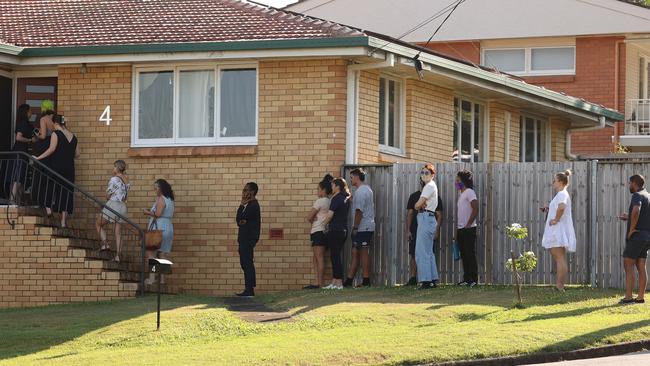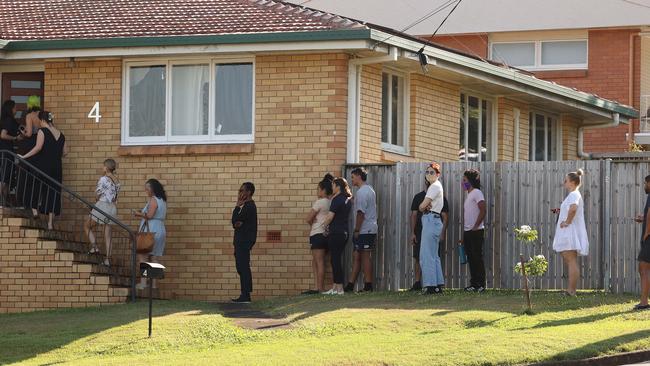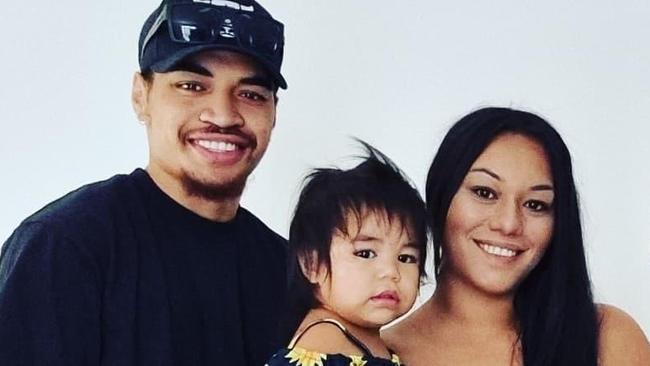Shocking figures reveal the state of Australia’s rental market
Australia is battling all-time-low vacancy rates and rental prices at record highs, the latest data has revealed.

QLD News
Don't miss out on the headlines from QLD News. Followed categories will be added to My News.
Australia’s rental crisis continues to worsen as new data shows the country is battling all time low vacancy rates and rental prices at record highs, with no sign of relief in sight.
The latest data from Proptrack shows that average weekly rental prices are averaging $420-$575 per week across the country’s major capital cities with ACT the most expensive, according to the latest figures. That’s a 19.7 per cent increase over the past five years.
Proptrack director for economic research Cameron Kusher says the rental market is very tight and with Australia returning to ‘Covid normal’ the market will continue to worsen as supply remains low but demand continues to grow.
“It’s a really tough market at the moment. We are seeing a lot of demand for property especially since cities have opened, people going back to university and overseas travel,” he said.
“Even markets where we weren’t seeing as much growth, like Sydney and Melbourne, have started to pick up.”
Melbourne and Sydney have seen rent increases of between 8.4 per cent and 9 per cent, respectively, for units over the past year, CoreLogic data shows. The vacancy rates for units in those markets have fallen to 1.9 per cent in Melbourne in April, from 5.7 per cent a year ago and 1.8 per cent for Sydney units, down from 4.2 per cent.
Houses in the greater Brisbane area, where the vacancy rate in 0.9 per cent, have seen the biggest rent increases in the past year, up 12.2 per cent, and a hefty 23.6 per cent over the past five years, for an average annual change over the period of 4.3 per cent.
Casey Kahi who rents a house with her family south of Brisbane in Holmview is one of the many tenants facing price increases and worrying about the market.
“We are on a yearly lease due to expire in November and we are expecting our rent to skyrocket as the properties around us have already started going up,” she said.
The vacancy rate is as low as 0.3 per cent in Adelaide for houses and units, where rents have gone up 9.5 per cent for houses and 7.8 per cent for units over the past year.
Rents for houses and units in Hobart are up 9.4 per cent (houses) and 7 per cent (units) over the past year and have skyrocketed 38.1 per cent and 36.7 per cent, respectively, over five years. The vacancy rate in the Tasmanian capital for houses is 0.9 per cent and units is 0.8 per cent.
Sydney’s housing rents have risen 9 per cent in the past year and by 5.1 per cent in Melbourne as vacancy rates sit at 1.4 per cent and 1.3 per cent respectively.
In some regional areas the rents have skyrocketed even more.
In the greater Gold Coast area rental prices for houses, where the vacancy rate is 0.8 per cent, have jumped 18.3 per cent in a year and 40.1 per cent over the past five years.
It’s a similar story for houses in Newcastle, with rents up 12.9 per cent in a year and almost 35 per cent in five years which is 28 times more than the annual five year increase in Newcastle of 6.2 per cent.

Proptrack’s Mr Kusher, said more investors are selling properties and that is impacting rental supply.
“We have seen a decline in active investors in the market, but we have also seen more investors selling out of the market, and most of those sales are going to private ownership and not investors,” he said.
“Some investors were selling to make a bit of a profit, but others were selling to use the funds to renovate their primary residences.”
Mr Kusher said while a rise in interest rates should see housing prices fall, the same cannot be expected for the rental market and it will be a long road ahead.
“As interest rates rise, we expect property prices to fall, but we do not have that same expectation of rents. We should also see more interest in the residential property market going forward,” he said.
CoreLogic head of research Tim Lawless said the rental market could get tighter as Australia returns to a new post-Covid normal.
“It’s extraordinarily tight and we are seeing vacancy rates at record lows across the entirety of the country, and rents are rising well above income levels,” he said. “Rents are increasing an average of 9 per cent per annum while wages are only increasing by 2.5–3 per cent per annum, so you can see why rent affordability is becoming a problem.”
As more tourists and migrants continue to enter Australia, rental demand is likely to pick up and some investors will choose to switch from long-term accommodation to Airbnb, which will place an even larger squeeze on supply.
“Outcomes for renters certainly aren’t looking very positive at the moment, and it looks like the rental situation could get even tighter,” Mr Lawless said.
“As we become more vaccinated as a population and Covid disturbances are mostly behind us, we probably will find that those inner city, higher density rental markets become more vibrant as people return to work and hospitality opens” he said.
LJ Hooker head of property management Nick Georges said that the market in Queensland is so tight due to an influx on people moving further north during the pandemic.
“It’s quite disturbing what is happening at the moment, especially in Queensland it’s not uncommon to have between 10-20 applications per property,” he said.
“One reason why Queensland is feeling the squeeze more is the influx of people from Sydney and Melbourne to Queensland for a lifestyle change during the pandemic.”
Mr Georges said recent weather events have also put pressure on the market.
“All the damaged homes from floods and weather events have caused people to relocate further north and out into the regions,” he said.

He said the best tip for renters looking to enter the market is to stay alert, sign up for waitlists and submit fully completed applications.
“People should ensure they submit full and complete applications with all documentation attached,” he said.
They can also set up notifications on sites such as realestate.com where you can be notified of rentals when they enter the market or go on waitlists,” he said.
Ms Kahi and her partner Levi are concerned they may not be able to find suitable housing and will have to relocate because they have a large family. Ms Kahi is pregnant and the family has four other children.
“My rent has been slowly increasing by $20 (a week) each year for the past three years and I don’t even want to know what it will be come November” she said.
“I think it’s always harder to get a rental with kids, and we have five. I know of a lot of people offering more than the weekly rent just to secure a property and have heard of people being forced out onto the street because the market is so bad here, ”she said.


